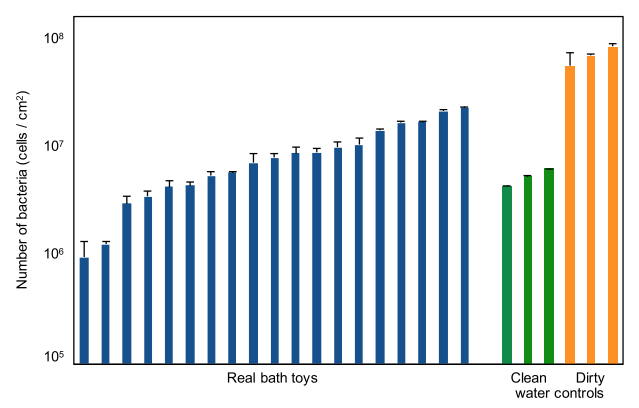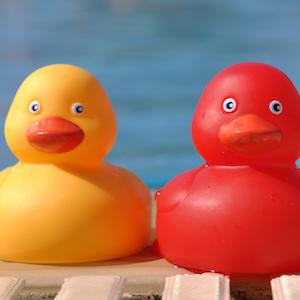I will never be out of a job because literally, every single day, something idiotic is trending either on Google or Twitter. Today, the trending term is "Rubber Duck."
Why? New research shows (gasp!) there are bacteria and fungi on the toy rubber duckies and other plastic toys that your toddler (or spouse) plays with in the bath tub. To create as much terror as possible, the scientists even provocatively titled the paper: "Ugly ducklings—the dark side of plastic materials in contact with potable water."
That's a big red flag. Serious scientists don't write titles for journal papers like that. Instead, a typical headline for a paper like this would be: "A survey of the microbial ecology of plastic bath toys." That's not a sexy, eye-catching headline, but that's the entire point. A scientific paper is supposed to be accurate, not sensationalist.
But sensationalism was the entire point of the paper. The very first sentence of the abstract proves it:
"Bath toys pose an interesting link between flexible plastic materials, potable water, external microbial and nutrient contamination, and potentially vulnerable end-users."
In other words, bath toys are dirty and a danger to your kids. The paper doesn't even examine any health effects, but that doesn't stop the authors from making a link in the very first sentence of the abstract. That's disingenuous. The abstract, for better or worse, is the most important part of the paper since few people (journalists and scientists included) read beyond it.
What the Scientists Did
The authors collected 19 bath toys from five local households and compared them to six control toys which were given to adults. Three of the adults were instructed to place the toys in clean bath water, and the other three were told to place the toys in used bath water. They did this every other day for 11 weeks. At the end, the microbial inhabitants of all the toys were determined.
 To the surprise of no one, bacteria were found everywhere. (See figure.) Fungi were found on the dirty water control toys and more than half of the real bath toys, but none of the clean water control toys.
To the surprise of no one, bacteria were found everywhere. (See figure.) Fungi were found on the dirty water control toys and more than half of the real bath toys, but none of the clean water control toys.
So what? Bacteria and fungi are everywhere, including kitchen sponges, doorknobs, cell phones, and toothbrushes. The bathtub itself is pretty gross. (Ever noticed the pink slime on the walls?) We have immune systems for a reason.
What the Scientists Said
The scientists, of course, know this. So, they decided to fearmonger a little bit more. They noted that they detected "potential opportunistic pathogen[s]" and bacteria that indicated "fecal contamination."
Gee, ya think? Perhaps the reason the toddler is in the bathtub in the first place is because he crapped his pants and has to be rinsed off. Toddlers are essentially walking, talking Petri dishes of infection. But they have immune systems, too, and they work pretty well.
Fearmongering Clickbait: Is that What Science Is Supposed to Be?
Amazingly, the authors cite mommy blogs and the sensationalist book Slow Death by Rubber Duck: The Secret Danger of Everyday Things in their paper. The book is about the dangerous "chemicals" that are poisoning everybody, a chemophobic tactic that we've debunked over and over again.
Quite honestly, I don't think I've ever seen anything like this in my professional career. Serious scientists don't cite mommy blogs and sensationalist popular science books in peer-reviewed journal papers.
The authors had a clear strategy in mind: (1) Do a study on a common household object; (2) Produce boring data that doesn't surprise any microbiologist; (3) Write a provocative, fearmongering headline; (4) Market it to a gullible, clickbait-hungry press (like the New York Times), who would repeat their claims without any criticism or critical thinking; and (5) Watch the media interview requests and grant dollars come rolling in.
Mission accomplished. The deceitful manipulation of the press for their own professional benefit would be a thing of fascination if it wasn't so utterly disgusting.
Source: Lisa Neu, Carola Bänziger, Caitlin R. Proctor, Ya Zhang, Wen-Tso Liu, and Frederik Hammes. "Ugly ducklings—the dark side of plastic materials in contact with potable water." NPJ Biofilms and Microbiomes. Published: 27-Mar-2018. DOI: 10.1038/s41522-018-0050-9




